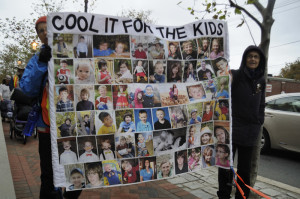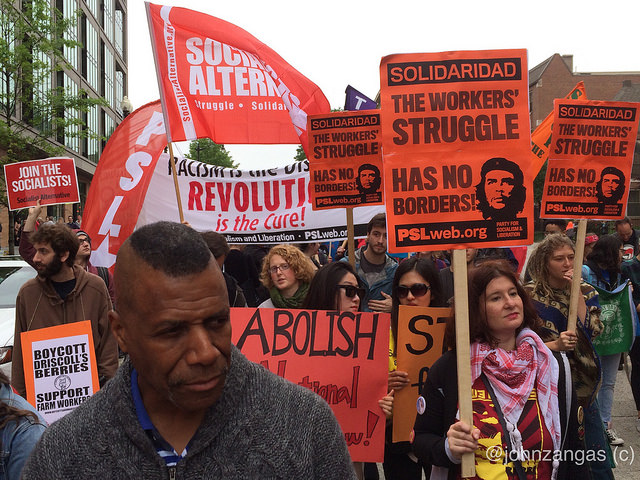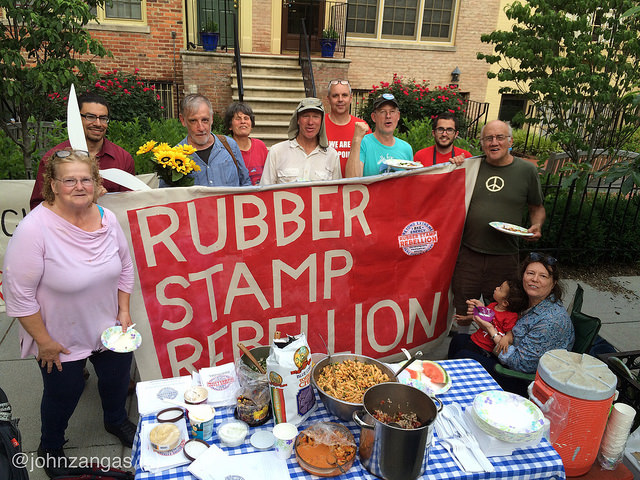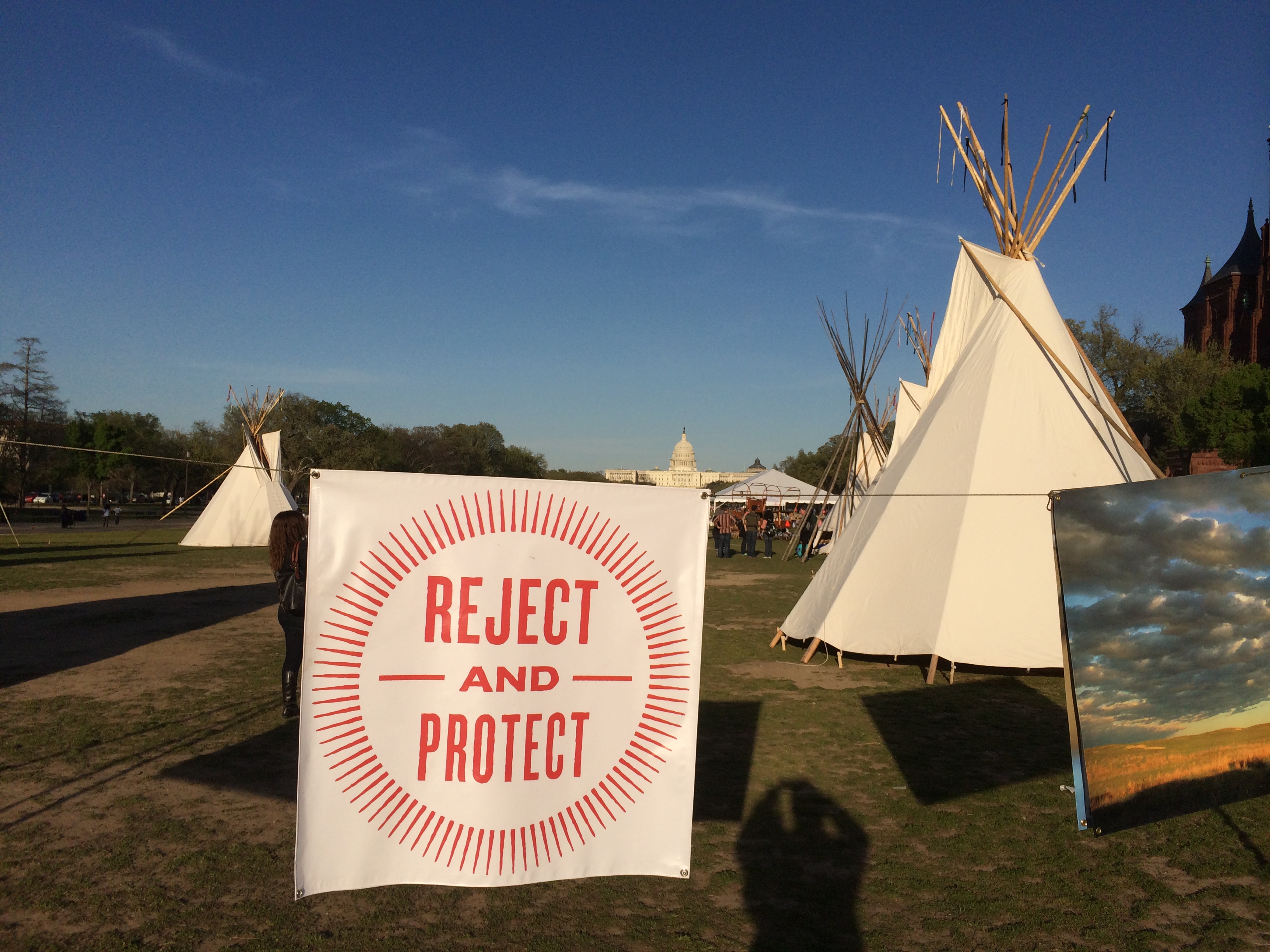The Great Climate March completed an eight month cross-country trek on Saturday, arriving at the White House. Enviros walked their last leg into Washington DC escorted by nearly 200 people. As they walked from Maryland into DC, the chanted the names of the 11 states they had crossed over 8 months. They sang songs accompanied by guitars and spoke of their experiences. Their arrival marks the beginning of a week of climate actions across the region.
As they arrived at the White House, they called on the administration to immediately begin fulfilling promises it made in 2008, to convert energy production to renewable sources–wind, solar and geothermal.
They read aloud messages written by citizens from across the country. A common theme among them was time was running out to prevent more environmental destruction from fossil fuel energy. In a symbolic gesture of commitment to the environment, they hugged a giant hundred year old oak tree near the White House.
Some walkers joined in the march at points later in the cross-country trek. But all of them gave testimonials of how their experiences were life changing events.
“This Is the Issue Of Our Times”
 Retired history teacher, Debrua James, from New Mexico, who wrote a high school curriculum on pubic sustainability education, said, “This is the issue of our times.” She was one of the original walkers who started from Los Angeles and was on her fourth pair of shoes. “If we don’t solve the climate issue, all other issues are moot,” she said.
Retired history teacher, Debrua James, from New Mexico, who wrote a high school curriculum on pubic sustainability education, said, “This is the issue of our times.” She was one of the original walkers who started from Los Angeles and was on her fourth pair of shoes. “If we don’t solve the climate issue, all other issues are moot,” she said.
James was inspired to keep going by closeness between marchers, referring to them as “my other family.”
“I will have relationships I know will see me through the rest of my life,” she said.
Impacts to Health from Climate Change
Thousands of fans supported the Great Climate March with over fifty organizations, including Physicians for Social Responsibility. Dr. Catherine Thomasson, its Executive Director, walked the last leg in support of the walkers. “We understand the grave impact on health from climate change,” she said.
Thomasson spoke of the advantages of renewable energy, from cutting pollution at the same time improving overall health. “From heat waves to sea level rise, infectious diseases, loss of homes, jobs and infrastructure, we can do a lot of things right now that solve these problems,” she said.
One of the original walkers, Ron Leman, said the walk was effective because of the “thousands of people we’ve talked to across the country.” He urged others to do something about the effects of climate change in their communities. “There’s got to be a change of mindset,” he said. “If we don’t do it willingly, we will be forced to do it with a lot of suffering.”
Climate Change Destroying Communities and Animal Habitat
Nowhere was the suffering more evident than in the Southwest, according to Judy Todd, an original walker who started in LA. She spoke of witnessing a barren bird habitat wrenched by drought. She said they “walked for days and days [with] no evidence of birds, birdsong, the dawn chorus, [and] there wasn’t one at sunset.” The change to habitat for people and animals made her realize how much climate change was impacting the environment. “It made me a me a conservationist in the sense of helping my friends understand how precious every bit of nature is and how important it is to be mindful of how were related to it,” she said.
Walking for over eight months while bearing witness to habitat destruction changed her outlook on what suffering can do. “It’s deepened my awareness of the suffering, and that could be a downer. But what I’ve seen is, out of suffering comes great love, and I think love will be one of the things that carries this movement,” she said.
Pilgrimage Prepared Walkers For Climate Actions
Steve Norris, a coordinator and co-organizer, spoke of the achievements from the difficult cross-country journey. He said the cross-country walk was a “pilgrimage” that helped bring communities together with a commitment to action for energy change. “The people on this march struggled to deal with all kinds of problems—food, weather, blisters-all the way across the country,” he said. This has given them solid training to organize for future actions like those planned this week at the Federal Energy Regulat ion Commission (FERC) on November 3-7.
ion Commission (FERC) on November 3-7.
He spoke of plans to take direct actions all week at FERC, the agency which permits gas pipelines and compressor stations across the country. “Beyond Extreme Energy will set up all week in front of FERC to block it,” he said. He spoke of the theatrical props which will be used to illustrate destruction of communities.
Activists plans will highlight consequences of FERC’s permitting of energy extraction projects in communities across the country. The marchers plan to set up mock communities and tents, and wear fracking towers to block FERC entrances all week.
“I have great grand-children, grand-children,” said Norris. “I lie awake at night wondering what kind of planet they’re going to inherit.”






